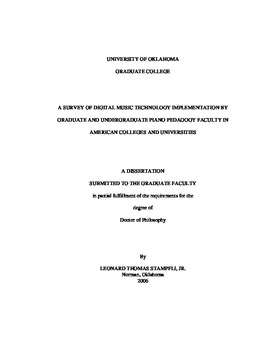| dc.contributor.advisor | Barry, Nancy, | en_US |
| dc.contributor.author | Stampfli, Leonard Thomas, Jr. | en_US |
| dc.date.accessioned | 2013-08-16T12:20:20Z | |
| dc.date.available | 2013-08-16T12:20:20Z | |
| dc.date.issued | 2006 | en_US |
| dc.identifier.uri | https://hdl.handle.net/11244/1071 | |
| dc.description.abstract | Distributions of 4 new summative scales revealed high usage of both generic and digital music technologies, with generally positive faculty attitudes toward digital music technologies. Respondents were placed into Rogerian adoption categories. Similarities were observed between these 5 types of technology adopters and Rogers' (2003) bell-curve model, but a more linear adoption-diffusion pattern was observed than was predicted by Rogers' S-curve model. | en_US |
| dc.description.abstract | The purpose of this study was to assess the current level of adoption and diffusion of specific digitally based instructional and music technologies by pedagogues in American graduate and undergraduate pedagogy programs. Data were collected from faculty members who listed piano pedagogy as an area of teaching interest in the Directory of Music Faculties in Colleges and Universities, U.S. and Canada, 2005--2006. The questionnaire sought information about faculty pedagogues, their attitudes toward and usage of generic and digital music instructional technology, and their categorization as Innovators, Early Adopters, Early Majority, Late Majority, and Laggards according to Rogers' (2003) model of technology adoption and diffusion. | en_US |
| dc.description.abstract | Based on 238 valid responses (34%), data results showed that the sample was 60.1% female. The majority (68.4%) belonged to 1 or more professional organizations, attended conferences annually (54.9%), with 42.2% attending at least 1 digital music workshop per conference. Respondents reported frequent usage of generic digital technologies but even greater use of digital music technologies. No significant gender effects were observed, but one-way ANOVA tests revealed that younger faculty members were significantly more likely to use digital music technologies (F = 2.9, p = .023). Significant correlations were observed between the usage of digital music technology and organizational memberships (r = .164), conference attendance (r = .157), and digital music workshop attendance (r = .492). Using correlation and regression tests, respondent attitudes were shown to be positively and significantly related to the use of generic digital technology and digital music instructional technology (r = .369, r = .664, respectively; p = .000). | en_US |
| dc.format.extent | xii, 300 leaves : | en_US |
| dc.subject | Music and technology. | en_US |
| dc.subject | Education, Technology of. | en_US |
| dc.subject | Piano Instruction and study. | en_US |
| dc.subject | Education, Music. | en_US |
| dc.title | A survey of digital music technology implementation by graduate and undergraduate piano pedagogy faculty in American colleges and universities. | en_US |
| dc.type | Thesis | en_US |
| dc.thesis.degree | D.M.E. | en_US |
| dc.thesis.degreeDiscipline | School of Music | en_US |
| dc.note | Source: Dissertation Abstracts International, Volume: 67-05, Section: A, page: 1679. | en_US |
| dc.note | Adviser: Nancy Barry. | en_US |
| ou.identifier | (UMI)AAI3220374 | en_US |
| ou.group | Weitzenhoffer Family College of Fine Arts::School of Music | |
